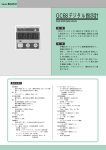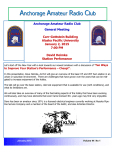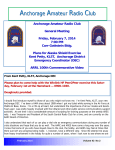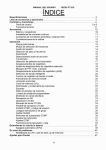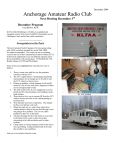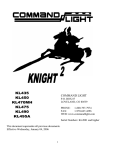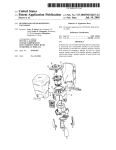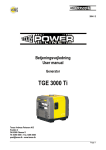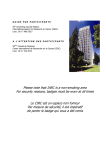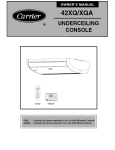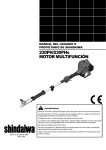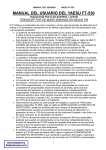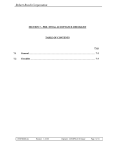Download April - Anchorage Amateur Radio Club
Transcript
Anchorage Amateur Radio Club Next Meeting April 3rd 2009, 7:00 PM APRIL PROGRAM: Lt. Col Timothy Bolin, with the Alaska Rescue Coordination Center will be providing a presentation about SARSAT, and emergency communications that are used in Search and Rescue. An ordinary ohmmeter cannot be used for measuring resistance of multimillions of ohms, such as in conductor insulation. To adequately test for insulation break down, it is necessary to use a much higher potential than is furnished by the battery of an ohmmeter. This potential is placed between the conductor and the outside surface of the insulation. An instrument called a MEGOHMMETER is used for these tests. A Megohmmeter generates a high voltage, low current signals for testing the breakdown strength of electrical insulation. They are called megohmmeter because the insulating resistance of a properly designed product is expressed in megohms (MO). Insulationresistance (IR) is the DC resistance between two defined points at a specific voltage in a controlled environment. Typically, the applied voltage is 500 VDC and the environment is 25° C with less than 50% relative humidity. EN 60204-1, a standard for machinery safety, states that for test voltages at 500 VDC, the minimum insulation resistance is 1 MO. EN 60335-1, a safety standard for household and similar electrical appliances, states that for test voltages at 500 VDC, the minimum insulation resistance is 5 MO. Important specifications for a megohmmeter include DC output voltage, DC output current, current leakage rate, resistance range, and test time. The type of electrical safety test determines the level of voltage or current that is supplied. For example, hipot testing usually produces very high voltage outputs and very low current outputs. Current leakage, another important specification for a megohmmeter, is the rate at which current flows through a ground conductor and is borne away safely. Resistance range measures a material’s opposition to the flow of electric current. Test time is the time required to complete the test. APRIL 2009 Megohmmeters vary in terms of display and interface technologies. Analog meters display values on a dial, usually with a needle or pointer. Digital meters display values with a numeric readout. Light emitting diode (LED) and liquid crystal display (LCD) devices are common types of digital meters. In terms of interface technologies, several types are available. General-purpose interface bus (GPIB) is designed to connect computers, peripherals and laboratory instruments so that data and control information can pass between them. RS232 or ANSI 232 is used for serial communications between instruments and computers. Megohmmeters with printer ports and scanner ports are also available. Devices with storage capabilities can provide printouts of formatted information. Megohmmeters provide many features. Remote controls permit control by computers or other instruments. Build-in calibration allows operators to calibrate test instruments without removing them from the test location. Warning indicator lights indicate pass/ fail conditions and often work in conjunction with audible buzzers or alarms. In automated test environments (ATEs), megohmmeters are often interfaced with programmable logic controllers (PLCs). Rapid cutoff circuitry protects devices from excessively high levels of voltage or current. User-selectable output frequencies, typically 50 Hz or 60 Hz, are commonly available. Front panel lockouts enable users to password-protect megohmmeters. Some manufacturers call this tamper-proof operation. There are a variety of applications for a megohmmeter. Some devices are used to test the insulation resistance of wires, cables, transformers, and electrical motors. Others are used to verify that devices such as aircraft fuel pumps meets manufacturer IR specifications. are also used to test the insulation-resistance of cable reels, rectifiers, solid-state diodes, and other electrical components. (cont. page 3) Volume 38, No 4 KL7AA HAMSHACK The KL7AA station is available for training in HF operations. Learn from an experienced HF operator about propagation, voice and Morse code modes as well as best practices and legal operations. The station is fully integrated with a PC and soundcard to operate in many digital modes. There are weekly contests to participate in even if just helping Hams all over the world gain points and multipliers to win awards. Your club station is quite capable and has great ears. Club operators have made many QSO's with all modes on all continents. Recent activities have seen SSTV QSO with New Zealand, hearing a Fallujah Iraq operator on PSK, a 15 meter contact to Peru during the CQ WW Phone contest. Common contacts are made with the lower 48 states and Caribbean, Canada, Japan, Korea, Taiwan, China, Russia and islands in the Pacific. Take advantage of this unique benefit! Arrange a session by contacting the club trustee, Keith Clark, KL7MM to meet at the KL7AA station on Rowan Street. Are you a member of ARRL? ARRL is the American Radio Relay League. This is the national organization that advocates on behalf of amateur radio operators to the FCC and the communications industry. KL7AA is an ARRL affiliated club with more than 50 years. Consider becoming a member of ARRL today. Fore more information about the ARRL DXCC Program check out: http://www.arrl.org/awards/dxcc/ +=+=+=+=+=+=+=+=+ News Letter Submissions, Information or corrections: Submissions must be received 2 weeks before meeting Email: [email protected] Mail: PO BOX 101987, Anchorage, AK 99510-1987 +=+=+=+=+=+=+=+=+ NEWSLETTER ARTICLES: All articles from members and interested persons are very welcome. If you wish to submit any articles, jokes, cartoons, please have it typed or neatly handwritten. It can be submitted by mail, computer disk or E-mail to the newsletter editor at the address listed above. Submissions must be in the hands of the editor no later than the 10 days prior to the meeting or it may not be included. If you like to stay in touch on KL7AA news and other posts of local interest. Step #1: First point your browser to: http://mailman.qth.net/mailman/listinfo/kl7aa Step #2: On the web page you will see a section titled "Subscribing to KL7AA". Enter your e-mail address in the "Your email address" entry box. Step #3: Pick a password for your account and enter it in the box marked "Pick a password" and then enter the same password in the box marked "Reenter password to confirm". This password will be used to change your settings on the list such as digest mode, etc. The MODULATION TIMES is the monthly newsletter of the Anchorage Amateur Radio Club, published by and for its members. The entire contents of this newsletter are copyright 2008 by the Anchorage Amateur Radio Club. Permission is hereby granted to any not for profit Amateur Radio Publication to reprint any portion of this newsletter provided both the author and Anchorage Amateur Radio Club are credited. Step #4: If you would like the e-mails in daily digest form click yes on the line marked "Would you like to receive list mail batched in a daily digest?" Step #5: Click on the "Subscribe" button below the information that you just entered. APRIL 2009 2 Volume 38, No 4 What are insulation resistance and leakage currents? During the testing procedure, the high dc voltage generated by pressing the test button will cause a small (micro-amps) current flow through the conductor and the insulation. The amount of current depends on the amount of voltage applied, the system’s capacitance, the total resistance, and the temperature of the material. For a fixed voltage, the higher the current, the lower the resistance (E=IR, R=E/I). The total resistance is the sum of the internal resistance of the conductor (small value) plus the insulation resistance in MΩs. The value of insulation resistance read on the meter will be a function of following three independent sub-currents. Conductive leakage current (IL ) Conductive current is a small (micro-amp) amount of current that normally flows through insulation, between conductors or from a conductor to ground. This current increases as insulation deteriorates and becomes predominant after the absorption current (see Figure 1) vanishes. Because it is fairly steady and time independent, this is the most important current for measuring insulation resistance. Polarization absorption leakage current (IA ) Absorption current is caused by the polarization of molecules within dielectric material. In low-capacitance equipment, the current is high for the first few seconds and decreases slowly to nearly zero. When dealing with high capacitance equipment or wet and contaminated insulation, there will be no decrease in the absorption current for a long time. During the short-time test, the MegOhmMeter is connected directly across the equipment being tested and a test voltage is applied for about 60 seconds. In order to reach a stable insulation reading in about one minute, the test should only be performed on low-capacitance equipment. The basic connection procedure is the same as for a proof test and the voltage applied is calculated from the dc test voltage formulas. When testing good equipment, you should notice a steady increase in insulation resistance due to decrease in capacitive and absorption currents. Capacitive charging leakage current (IC ) When two or more conductors are run together in a raceway, they act as a capacitor. Due to this capacitive effect, a leakage current flows through conductor insulation. This current lasts only for a few seconds as the dc voltage is applied and drops out after the insulation has been charged to its full test voltage. In low-capacitance equipment, the capacitive current is higher than conductive leakage current, but usually disappears by the time we start recording the data. Because of this, it is important to let the reading “settle out” before recording it. On the other hand, when testing high capacitance equipment the capacitive charging leakage current can last for a very long time before settling out. APRIL 2009 3 Volume 38, No 4 The Alaska DX Club (KL7DX and KL7CQ) has been granted a third call sign which we will be using for a yearlong special event (2009) in honor of the 50th Anniversary of Alaska's Statehood. The call sign is KL5O. Attached a picture of what the QSL card will look like. CORNEY EASTMAN, KL0FK is offering a great Electronics Class on Friday evenings at the KL7AA HAMSHACK. The classes are open for anyone wanting to learn The toilet at the KL7AA hamshack was recently replaced to accommodate our aging members. A complete hamshack with full accommodations! more about electronics or test equipment used in radio applications, anyone who wants to test or troubleshoot radio or antennas. This informal fun class discusses design and equipment options that might be used to build a radio. RADIO KITS are available to purchase and build. Bring your questions and projects to the KL7AA Radio shop on Friday Evenings at 530PM. The class is currently scheduled to meet on the following nights: 4/10, 4/17, 4/24 THANKS TO CORNEY for offering this course APRIL 2009 4 Volume 38, No 4 Step voltage test The step voltage test involves resistance testing at various voltage settings. In this test, you apply each test voltage for the same period of time (usually 60 seconds), graphing the recorded insulation resistance. By applying increasing voltages in steps, the insulation is exposed to increased electrical stress that can reveal information about flaws in the insulation such as pinholes, physical damage, or brittleness. Good insulation should withstand an increase in over-voltage stress and its resistance should remain approximately the same during testing with different voltage levels. On the other hand, especially at higher voltage levels, deteriorated, cracked or contaminated insulation will experience an increased current flow, resulting in a decrease in insulation resistance. This test is independent of insulation material, equipment capacitance, and temperature effect. Because it takes a longer time to run, it should be performed only after an insulation spot test has been inconclusive. A spot test deals with absolute resistance change (single reading) with respect to time, while the step voltage test looks for trends in resistance, with respect to varying test voltages. Dielectric-absorption / time-resistance test The time resistance test is independent of equipment size and temperature. It compares the absorption characteristics of contaminated insulation with the absorption characteristics of good insulation. The test voltage is applied over a 10 minute period, with the data recorded every 10 seconds for the first minute and then every minute thereafter. The interpretation of the slope of the plotted graph will determine the condition of the insulation. A continuous increase in graphed resistance indicates good insulation. A flat or downward curve indicates cracked or contaminated insulation. APRIL 2009 5 Volume 38, No 4 I have a list of Ham gear I want to sell, they will go on eBay soon if they don’t sell here in Alaska. If you need any more info please ask. Home phone is 376-2857, email is [email protected] I can bring anything to town to the club meeting. Thanks 73 Tom, NL7TZ ICOM IC R7000 $600.00 Description: 25 - 1000/ 1025 - 2000 MHz multimode communications receiver with 99 memory channels. Operator’s manual and service manual. Have 3 of these, 2m/440 HT Yaesu FT-530, FBA-12 (6 AA DRY CELL CASE), MH-29A2B LCD Display mic with remote functions, $350.00 Yaesu FT-530, FNB-26S AND FNB-26 batteries, MH-29A2B LCD Display mic with remote functions, VINYL CASE, NC-42, QUICK CHARGER $350.00 Yaesu FT-530, 3 EACH FNB-25, DESKHARGER $250.00 Brand new Simpson 260-8 volt-ohm meter $200.00 SGC SG-2000 HF Transceiver, no mic $750.00 This is an extremely high quality 150 watt HF SSB, CW and AM Transceiver for Marine or Ham use APRIL 2009 6 ANCHORAGE AMATEUR RADIO CLUB MEMBERSHIP MEETING March 6, 2009 Carr Gottstein Building – APU Campus Anchorage, AK Call to Order The meeting was called to order at 7:00 PM by President Randy Vallee, KL7Z. Members and guests introduced themselves. Thirty-nine were in attendance Presentation Jerry Matthews of Municipal Light and Power gave a presentation on Power Distribution in South Central Alaska and Standby generator installations. Jerry’s department is the Distribution Transformer Shop/Facility Maintenance. Jerry provided a layout of the 17 Distribution plants connected throughout South Central and Interior Alaska. These plants are between Delta Junction in the Interior and Bradley Lake across the bay from Homer and feed the large neighborhood substations. Several Power Dispatch centers are used to broker power throughout this section of the state and keeps power flowing to the customer. Power is then distributed throughout the distribution system by the use of transformers which regulate the voltage down from the high voltage transmission for distribution. In high density areas, the loop feed system is used with one switch in the loop locked open. This provides for redundancy in situations such as cable failures or downed lines and provides the ability to reroute power to the area and minimizing the affected users. Where the density is lower, the radial feed system is used. The drawback to this type of feed is that extended power outages may be experienced while repairs are made. Power linemen are reminded of their own safety in situations where they are focused and intent on getting the power back on. Jerry discussed the incident where a raven caused a flash over in a substation and the domino effect which caused 2/3 of South Central Alaska to go black as a result. Jerry noted the use of hydro electric power from the Bradley Lake, Cooper Lake and Eklutna Lake facilities, coal at the Fairbanks and Healy plants, natural gas at the Chugach Electric and ML&P plants and diesel and bunker fuel generators at other facilities. Jerry noted that Delta Junction used to have a small nuclear power plant that is no longer in use. Volume 38, No 4 KL7AA General Meeting Club Business transfer switches vs. automatic, grounding issues, National Electrical Code article 702 requirements and the bottom line that the installation needs to be safe. Discussion was also held on co-generation, geo thermal, tidal, and in-river generation systems, legally required standby systems in hospitals, schools, assembly points, and other similar facilities, use of coal and emissions, dwindling natural gas supplies, wind farms, and the proposed new substation in Anchorage at International and Minnesota. Business Randy Vallee noted the open Activities Manager position on the AARC Board of Directors. Pat Wilke WL7JA volunteered for the position and was approved by the AARC Board of Directors at the February Board Meeting. Randy asked for a show of hands to approve Pat to the position. There was no opposition. Randy Valley noted that T.J. Sheffield was going to be putting forth a proposal for the purchase of emergency response equipment and requests input from members at the weekly sessions at the Rowan Street ham shack. The meetings are held every Wednesday at 7pm. T.J requests input and thoughts regarding emergency preparedness and also thoughts about the upcoming Field Day. OTHER Heather Hasper, KL7SP made the following announcements: Heather thanked the volunteers for the Fur Rondy event and handed out certificates for participating. A statewide ARES training session will be held at the APU campus at 9:30am on March 21st. The training will be on Winlink and will be presented by the Fairbanks radio club. A joint exercise will be held on UAA campus involving UAA, Red Cross and OEM on Monday, March 23rd. Two shifts of volunteers are requested. A 930am-3pm shift and a 230pm-8pm shift. Contact KL7SP at ARRL.net for information and to volunteer Door Prize Drawing WL7CPX, Nancy, KL2HC, KL2OS and KL7MM. General discussion noted the age of the turbines in use in Anchorage which are 25-30 years old. Complete rebuilds of these units are done on regular intervals, coordination issues between utilities for transferring power, isolation capabilities during disasters, weak links in the power grid such as the Seward area due to avalanches, Whittier due to the tunnel, Hope due to fuel constraints. The installation of standby generation for homeowners was discussed and a handout detailing the requirements of the 3 local utilities were provided as handouts. Jerry noted that an individuals location would have a major part in the decision of how much to spend on a standby system, what the standby load requirements would be, what the critical loads might be, what type of electrical/electronic equipment would be powered, is the generator permanently installed or cord and plug connected. Jerry noted that a permanently installed generator has more stringent requirements to satisfy Utility and Code enforcement agency rules. Transfer switches, if used, are required to be rated the same as the utility service is to the residence (i.e. 100 amp, 200 amp etc.), Multiple circuit switching assemblies are available locally which allow for switching critical circuits between utility and generator power without the installation of a transfer switch. Estimated costs for the installation of standby generation are $500 per kilowatt if the work is done by the homeowner and can range to the area of $1500 per kW if installed professionally. Jerry noted the average home requires between 5 to 10kw to power standby equipment and circuits. Discussion noted the installation of equipment in the Municipality of Anchorage requires an electrical permit, a homeowner (not renters) may obtain the permit and do the work themselves with a diagram of the intended installation, all utilities have requirements for installation and will inspect the installation to verify the installation for safety and protection of the crews working on the utility power during an outage. Jerry noted that a generator supplying 120v to a residence that is improperly installed can produce 7200v by back-feeding a transformer and energizing the primary lines. Discussion noted that the less expensive the generator the lower quality of power provided, automatic vs. manual transfer switches, permanent vs. portable generators, site considerations, noise issues with generators, life safety issues for some, utility requirements are easier with manual APRIL 2009 The meeting adjourned at 8:50pm. Submitted as recorded on March 6, 2009 by: Richard Tweet, KL2AZ Secretary 7 Volume 38, No 4 KL7AA Club Business ANCHORAGE AMATEUR RADIO CLUB BOARD MEETING March 17, 2009 540 WEST INTERNATIONAL ROAD Anchorage, AK (UNAPPROVED at Printing) TREASURER’S REPORT The meeting was called to order at 7:00 PM by President Randy Vallee KL7Z. Calex Gonzalez KL2BT gave the financial report for month ending February 2008. Calex noted the treasury is healthy, no grants are before the Board and Field Day purchases have not been made yet. Motion made Heather Hasper KL7SP, seconded Michael O’Keefe KL7MD to accept the Treasurers report as given. The motion carried unanimously BOARD MEMBERS PRESENT: VE REPORT President Randy Vallee KL7Z, Vice President Heather Hasper KL7SP, Secretary Richard Tweet KL2AZ, Treasurer Calex Gonzalez KL2BT, Activities Manager Pat Wilke WL7JA, Past President Kathleen O’Keefe KL7KO, Eric McIntosh KL2FM , Susan Woods NL7NN, John Orella KL7LL, T.J Sheffield KL7TS, Tom Rutigliano NL7TZ, Michael O’Keefe KL7MD, Sean Jensen KL2CO, Hugh McLaughlin KL7HM Eric McIntosh KL2FM reported that testing remains steady with two people passing the Technician exam, 1 passed the General exam and 1 passed the Extra exam at the last session. NON-VOTING MEMBERS PRESENT MEMBERSHIP REPORT Keith Clark KL7MM There was no membership report as Fred Erickson was not in attendance. EXCUSED TRUSTEE REPORT Keith Clark KL7MM reported that there was nothing new to report ARES TRAINING Bruce McCormick KL7BM Membership Survey – Heather Hasper KL7SP Heather Hasper reported that the Fairbanks Arctic Amateur Radio Club would be presenting a statewide ARES training session on March 21st. The training will be hosted by the AARC at the Alaska Pacific University beginning at 9:30am in the Carr Gottstein Building. Heather also reported on the upcoming UAA/ Municipality of Anchorage joint exercise which will be held on March 23rd as well as the upcoming Anchorage International Airport disaster exercise to be held on June 6th. GUESTS OLD BUSINESS Bill Fults KL1UK CCV TOILET UNEXCUSED Craig Severson KL2FN REQUEST FOR AGENDA ITEMS Travel and Unavailability - John Orella KL7LL D-Star repeater availability - Tom Rutigliano NL7TZ T.J. Tombleson KB8JXX Michael O’Keefe reported that the new toilet had been installed at the CCV garage and was complete. SECRETARY REPORT Previous Board meeting minutes for the February Board meeting were presented as well as the membership meeting minutes from the March membership meeting. Discussion noted the misspelling of an Officer’s name. Motion made John Orella KL7LL, seconded Michael O’Keefe KL7MD to accept the minutes as presented/ corrected. The motion carried unanimously. APRIL 2009 8 REAL ESTATE Keith Clark KL7MM reported on the banks requiring a down payment of 40% instead of the normal 25% which would likely result in the AARC being able to purchase a $400,000.00 building with current funds. Keith noted this severely limits appropriate property choices to accommodate the AARC’s requirements. Keith noted he will continue to watch the market. Volume 38, No 4 KL7AA Club Business CLUB TEST EQUIPMENT Heather Hasper KL7SP reported that the test equipment discussed at the last Board meeting had been purchased from Jim Wiley KL7CC and was in use at the AARC CCV facility. Heather reported that the policy for use of club assets was still in draft format and was still being developed. AARC BOARD OF DIRECTORS TRAINING Randy Vallee asked for input on the recent Foreaker Group Board of Director training provided to the AARC Board of Directors. General discussion was all very positive with the suggestion the training occur annually and additional training be sought in the Finance Committee and Project Management areas CCV SECURITY Michael O’Keefe KL7MD reported that the project is not complete and is waiting on installation of equipment and devices. CCV VEHICLE Michael O’Keefe reported that the leveler jack system is in need of repair as it is inoperative. Michael is working on finding a facility to repair it. CCV CONFERENCE PHONE Brief discussion was held on conference phone availability in the CCV facility. Discussion was held on the prototype multiple headset monitoring/mentoring INTERCOM station being tested by the club and the possibility of using off the shelf aviation type equipment to accomplish the same goal. WILEY TEST GEAR This was discussed as noted above. Heather Hasper noted that Corny Eastman KL0FK will be out of town on business until the beginning of April. was held on the use of debit cards by club members for club purchases for repairs and improvements to club assets and the reimbursement policy of the club. Randy Vallee noted the AARC Bylaws Committee will review the policy. BOARD MEMBER TRAVEL John Orella KL7LL noted that he will be travelling from the 7th of April until the middle of June and will be unavailable for AARC business. Tom Rutigliano reported that he would be gone during May and June and would also be unavailable. D-STAR REPEATER AVAILABILITY Tom Rutigliano NL7TZ reported that Mike Romanello KL7BK was interested in selling his D-Star repeater. Discussion was held on AARC interest in obtaining this system, use and equipment requirements for D-Star, and current status of the system. Sean Jensen KL2CO noted this was appropriate for the Technical Committee to pursue. Tom will find out particulars on the equipment and sale price and report back to the committee. MEMBERSHIP SURVEY Heather Hasper inquired as to the status of the AARC membership survey discussed at the February Board Meeting. Hugh McLaughlin reported that he had not initiated the survey yet. ARES HF EQUIPMENT PURCHASE T.J. Sheffield KL7TS gave a presentation of a Capital Projects funding request for additional club equipment. This was in addition to the presentation during the February AARC Board meeting and was intended to be more detailed and address questions raised by the Board. T.J. noted this proposed matrix of equipment would allow for deployment without tearing down of club station equipment or borrowing personal equipment and could be available for use at Field Day. Equipment proposed for purchase consists of: NEW BUSINESS BOARD POLICY CREDIT CARDS ON USE OF PERSONAL Discussion was held on the AARC Board Policy regarding the use of personal credit cards for club purchases. It was noted that the AARC Bylaws and Articles of Incorporation prohibits the personal gain by any officer of the club and the club’s policy is that no personal credit cards will be used for the purchases of the AARC. Discussion APRIL 2009 9 Volume 38, No 4 KL7AA Club Business 4 Laptop computers with external mouse, keyboard, This proposed $26,000.00 purchase was approved by the AARC Board during the February Board meeting and will go the membership for a vote on the April 3rd general membership meeting. President Vallee expressed his appreciation to T.J. Sheffield and Keith Clark for their work on the presentation and Field Day preparations. and monitors. These will allow for portability and rapid deployment. One would be used for the satellite station, one for the training station and 2 for the primary transmitters. These higher end laptops would allow for multiple applications to be open in an emergency. 3 MicroHAM micro KEYERS. One for each of the proposed Elecraft stations and one for the GOTA station. Micro KEYERS provide multi-mode capability. T.J. noted the new ARRL Triple Play award for Voice/CW/Digital contacts. 2 Elecraft K3 transceivers 1 SGC mobile amplifier (would be wired into CCV permanently) 200’ control cable Guy ropes to allow for 2nd guy connection on towers Shipping and contingency T.J. TOMBLESON PRESENTATION T.J. Tombleson KB8JXX gave a presentation to the Board detailing the Cliffside Amateur Radio Association’s (CARA) project for a Statewide Linked Radio Project. T.J. noted this project will provide for 24 linked repeaters and is proposed to be installed in 3 phases. AT&T Alaska has partnered with CARA and will provide for free hosting of the equipment as well as installation by their technicians. T.J noted that it will cost CARA approximately $8,000.00 per site in support equipment to bring online. Discussion included frequency pairing, control operator availability, control link via leased lines, project budget, support personnel and equipment, sites included per phase, repeater interconnection, project engineering, grant availability, requirements and procedures, ArcticCom experience in development, inter-operative agreement, project timeline, use of system for ARES, 501c3 non-profit requirements. T.J. noted that details and site plots are available on the www.WL7CWE.org website. T.J. provided a view of the proposed layout, noted this was a legacy system, noted the fundamental question was the capability to provide communications, provided a history of AARC purchases to improve the deployment/portable capabilities, noted the 2 Elecraft radios would be used as the primary transmitters for DX capabilities and the use of a regional/statewide training station using multi–mode capability at 150 watts and a SteppIR antenna, the GOTA station would be a duplicate of the CCV facility club station using a Mark V and a Micro KEYER, provided a cost comparison of AARC costs associated with the ownership of VHF/ UHF repeaters as compared to this purchase, noted the availability to provide wireless and HinterNET support to agencies, noted training opportunities available at CCV facility during contests, MISC. DISCUSSION Heather Hasper KL7SP reported that the Kenwood repeater removed from Grubstake for repair is being sent back to Kenwood USA for repairs due to undocumented modifications and will be returned to its original configuration Michael O’Keefe KL7MD noted the missing TNC and radio from the CCV facility has been returned to the facility and is back in place in its kit. Board discussion of the proposal included; 2 K3’s would be needed to provide both DX and NVIS communications, K3’s are portable and more robust per the reference material presented, Why laptops vs. desktop pc’s, Could existing club assets be used in lieu of purchasing new, What is the minimum needed to operate on Field day, Project would be for ARES communication response and tested on Field Day and Sweepstakes events, Who will provide ARES training for use of equipment acquired, Purpose is for commonality of equipment, What operator training will be provided to the membership and who will be providing the training, Training opportunities other than contesting, Wise use of club finances, Past purchases not used. APRIL 2009 ADJOURNMENT Motion made Tom Rutigliano NL7TZ, seconded Michael O’Keefe KL7MD to adjourn. Motion carried. The meeting adjourned at 8:55pm. Respectfully submitted as recorded on 03/17/09 by Richard Tweet, KL2AZ Secretary 10 Volume 38, No 4 APRIL 2009 11 Volume 38, No 4 APRIL 2009 12 Volume 38, No 4 5th Thursday: Pet Emergency 1st Thursday: HT / Portable 2nd Thursday: Mobile Madness 3rd Thursday: RED CROSS 4th Thursday: Emergency Power ARES NETS: www.aresalsaska.org Alaska Pacific University; 0930 MON & WED Evenings 6PM - 9PM APDEA Union Hall Class 4/6 - 4/29 HAM RADIO Alaska Pacific University; 0930 Contact Heather, [email protected] [email protected] or 275-7474 3/18 ARES TRAINING KL7AA & KL7JFU ARES DISTRICT 7 & 5 Mon Tue 26 19 12 5 HAM CLASS 27 28 HAM CLASS 29 HAM CLASS HAM CLASS Meeting 7PM 22 AARC Board HAM CLASS 15 HAM CLASS MARA Board Meeting 7PM 8 21 14 7 1 Wed 20 HAM CLASS 13 HAM CLASS 6 Parka, meets at Denny’s on Denali at 11AM Contact: Lil Marvin NL7DL, 277-6741 EARS: R1 North, Third Saturday of each month. Contact: Ron Keech: [email protected] Sun PET Emergency 30 23 16 9 2 Thu MARA meeting 7PM 24 17 10 AARC Meeting 7PM 3 Fri ARES NET:Thursday Nights 8:00 PM 147.27+ PL:103.5 or 443.30+ PL 103.5 April 2009 25 EARS 930 ARES Training 18 PARKA meeting 11 AM 11 4 Sat Anchorage Amateur Radio Club PO BOX 101987 Anchorage, AK 99510-1987 www.KL7AA.net PUBLIC SERVICE ACTIVITIES Public Service ARES - Section 7, District 7 (Anchorage, ALASKA) Listed below are events that local radio clubs and event coordinators are looking for communication volunteers to support these upcoming public service events. Your participation is appreciated. While April is a quite month for public service activities, Spring is just around the corner and Summer events will soon be here. Here are some of the dates and events in May that we will be looking for volunteers. 5/2 Walk for Hope Contact: John Lynn, KL7CY, [email protected] 5/17 Gold Nugget Triathlon Contact: Heather Hasper, KL7SP, [email protected] 6/20 Mayors Marathon Mission statement: Dedicated to amateur radio as it pertains to disaster services. The history of amateur radio operators' involvement in sending life-saving information in and out of disaster areas [and] providing help during and after earthquakes, floods, hurricanes and tornadoes. "HAM’s have been there to assist local, state, and federal agencies and relief organizations such as the American Red Cross and Salvation Army." When All Else Fails, Amateur Radio. 6/28 FIELD DAY WHEN: APRIL 18, 2009 EMERGENCY EXERCISES SUBJECT: This spring will bring many opportunities to practice emergency communication scenarios with multiple agencies. Do you have coax laying around in piles wondering if it works or if it is still good? Perhaps the connectors are rusted out and you need help in changing the connectors. On Saturday April 18, 2009 we will have test gear setup and soldering irons set up at Alaska Pacific University to allow participants to bring their coax to the training and learn how to put on connectors and how to test the resistance of your coax. Multiple stations will be set up to allow for many operators to use the equipment. Be sure to LABEL any of your coax so not to get them confused with others that may be there testing as well. Corny Eastman, KLOFK will be providing the training. On Saturday, June 6, 2009, Anchorage International Airport will be practicing a disaster operations exercise. Due to the size of ANC International, the airport is required to complete this exercise every 3 years as part of the recertification of the airport under Federal Aviation Regulations Part 139. This training exercise will involve a simulated aircraft crash on or near airport property. This training exercise will help the airport prepare for it’s response to an aircraft accident. This is a multi-agency exercise. Many client agencies will be participating including Anchorage Office of Emergency Management, AFD, APD, State Troopers, Providence Hospital, Regional Hospital, Kulis Air National Guard, USFW, USCG, Port of Anchorage as well as many other Non Government Organizations. More details about volunteer opportunities in future newsletters. There are plenty of opportunities for operators who enjoy all modes of amateur radio to get involved in your club activities. APRIL 2009 ARES District 7 Contact Information Michael O’Keefe, KL7MD DEC7 at kl7aa.net 13 Volume 38, No 4 Any AARC sponsored repeater, with or without an auto-patch, will always be open to all licensed amateur radio operators in the area who are authorized to operate on those frequencies. Data You Can Use: Anchorage & Mat Valley Area Repeaters-a/o JAN 1 2009 KL7AA: Flattop Mountain 2,200 ft 2009 Board of Directors President: Randy Vallee, KL7Z president at kl7aa.net Vice Pres: Heather Hasper, KL7SP vicepresident at kl7aa.net Secretary: Richard Tweet, KL2AZ secretary at kl7aa.net Treasurer: Calex Gonzalez, KL2BT treasurer at kl7aa.net Activities Chairman: Pat Wilke, WL7JA activities at kl7aa.net Trustee: Keith Clark, KL7MM trustee at kl7aa.net Membership Chairman: Fred Erickson, KL7FE membership at kl7aa.net News Letter Editor: Heather Hasper, KL7SP editor at kl7aa.net Three Year Board Members Michael O'Keefe, KL7MD mok at gci.net (3rd Year) Eric McIntosh - KL2FM, kl2fm at arrl.net (2nf Year) Bruce McCormick, KL7BM kl7bm at arrl.net (1st year) 146.94/34 MHz, 80 watts, auto-patch, 141.3 Hz PL 224.94/223.34, 25 watts, no patch, no PL 444.70/449.70, 25 watts, auto-patch, 103.5 PL WL7CVG: Mount Susitna 4,396 ft VHF: WL7CVG/R1 147.270/147.870 PL 103.5, no auto-patch UHF: WL7CVG/R3 443.300/448.300 PL 103.5, no auto-patch WL7CVF: Grubstake: Hatcher Pass 4,536 ft VHF: WL7CVF/R1 147.330 / 147.930 PL 103.5 Hz (no patch) UHF: WL7CVF/R3 443.900 / 448.900 PL 103.5 Hz (no patch) KL7ION at Mt. Gordon Lyon: PARKA 3,940 ft 147.30 / 147.90, MHz - 80 watts, no patch, 141.3 Hz PL KL7AIR Elmendorf AFB: EARS: 146.67/146.07, 107.2 Hz PL KL7CC, Anchorage Hillside, SCRC & QCWA 146.97/.37 MHz, 30 watts, auto-patch, 103.5 Hz PL KL7M Anchorage Hillside 147.21 / 147.81 MHz, on IRLP, 97.4 Hz PL KL5E Chugiak: 147.15/147.75, 123.0 Hz PL, auto-patch KL7JFU, KGB road, MARA: 146.85/146.25, auto-patch, no PL Palmer IRLP: 146.64/.04, simplex patch, no PL Mile 58.3 Parks Highway IRLP: 147.09/.69 MHz, 97.4 Hz PL Winlink VHF RMS 145.190 MHZ, mode is Packet.KL7JFT-10 One Year Board Members TJ Sheffield - KL7TS, kl7ts at arrl.net Craig Severson - KL2FN, chipman at clearwire.net John Orella: KL7LL, kl7ll at arrl.net Susan Woods: NL7NN, NL7NN4606 at yahoo.com Tom Rutigliano, NL7TZ, tomr at alaska.net Sean Jensen, KL2CO, sean.jensen at gmail.com Hugh McLaughlin, KL7HM kl7hm at arrl.net KL3K, Girdwood - IRLP 146.76 / 146.16 MHz, 25 watts, no patch, 97.4 Hz PL KL7AX: South Anchorage IRLP - 146.79/ 146.19 MHz, 100 Hz PL WL7CWE: Cliffside Amateur Radio Association WL7CWE Anchorage IRLP Kathleen O’Keefe, KL7KO (Past President) kok at woodscross.net 2 Meter: 146.82/146.22MHz PL 103.5 6 Meter: 51.65 output / 51.15 input, PL 103.5Hz 70 cm: 444.85/449.850 MHz PL: 103.5 Hz (Node 3400) AARC web page & Email contact addresses: Homepage: http://www.KL7AA.net/ Webmaster: webmaster at kl7aa.net Membership: membership at kl7aa.net Newsletter: editor at kl7aa.net South Central Area Simplex Frequencies 146.52 MHz Calling and Emergency frequency 147.57 MHz National DX Calling / Coordinating frequency 146.49 MHz Anchorage area simplex chat 146.43 MHz Mat-Su Valley simplex chat 147.42 MHz Peninsula simplex chat 146.58 MHz Simplex IRLP - Wasilla Lake News Letter Submissions, Information or corrections: Submissions must be received 2 weeks before meeting Email: editor at kl7aa.net Nets in Alaska: VHF The following nets are active in South-Central Alaska: HF HF ARES Net: 147.27/87 103.5Hz - Thursdays at 8:00 PM local Alaska Sniper's Net PARKA Net 147.30/.90, 141.3 HZ Thursdays at 7:00 PM local 3.920 MHz 6:00 PM daily Morning Road and Weather Report: 147.27/87 103.5Hz - Daily at 9:00 AM Alaska Bush Net: 7.093 MHz 8:00 PM daily No Name Net: 146.85/.25 repeater Sundays 8:00 PM Alaska Motley Net: 3.933 MHz 9:00 PM daily and 1900 - 2400 Alaska Time - AL7N or KL5T monitoring. ACWN (Alaska CW Net) Big City Simplex Net: 146.520, 446.0, 52.320 FM, 29.6 FM, 28.400 USB 3534, 7042 Daily @ 0700 –1000, With Packet 145.01 and 147.96, Tuesdays 8:00 PM local Net Purpose:Formal NTS traffic via CW. Grandson of SSB Net: 144.20 USB Mondays 8:00 PM local Alaska Pacific Net: Alaska VHF Up Net: 144.200 USB Saturdays 9:00 AM local Statewide LINK Net: 147.27/87 103.5Hz Sunday 8:00 PM local 14.292 MHz 8:00 AM M-F Echolink: KL7M ERC HF Net: 3.880 MHz – Sunday 8:30PM APRIL 2009 14 Volume 38, No 4 Internet Links, the favorites from our readers: AARC http://www.KL7AA.net SCRC http://www.KL7G.org EARS http://www.kl7air.us MARA http://www.kl7jfu.com Moose Horn ARC http://www.moosehornarc.com PARKA http://www.parka-kl7ion.com ARES http://www.aresalaska.org Practice Exams : http://www.AA9PW.com Fairbanks AARC: http://www.kl7kc.com/ ALASKA MARS: http://www.akmars.org Alaska VHF-Up Group: http://www.kl7uw.com/avg.htm Béthel Amateur Radio Klub: http://www.al7yk.org/ Yukon Amateur Radio Association: http://www.yara.ca/ Links for Propagation http://www.haarp.alaska.edu/ QRP and Homebrew Links http://www.AL7FS.us Solar Terrestrial Activity http://www.spaceweather.com http://www.swpc.noaa.gov/ ARRL http://www.arrl.org/ Propagation Report Recording 566-1819 Please let us know if there are other clubs pages or good starting points that should appear here. Report dead links or bad info to [email protected] MONTHLY EVENTS st 1 Friday each month: AARC general meeting 7:00 PM in the Carr-Gottstein Building, on the APU Campus. Talk in will be on 147.27+ repeater. 1st Tuesday each month (except for holidays): VE License Exam 6:30 PM, at the Hope Cottage offices, 540 W International. Bring photo ID, copy of license (if any) and any certificates of completion. Contact: Jim Wiley, KL7CC 338-0662. 2nd Saturday each month: PARKA Meeting at 11:00 AM. Polar Amateur Radio Klub of Alaska. All amateurs welcome. Denny’s on Denali Street in Anchorage. Talk in on 147.30+. 2nd Saturday each month (except for holidays): VE License Exams at 2:00 PM. at Hope Cottage 540 W. International. Be sure to bring photo ID, copy of license (if any) and any certificates of completion. Contact: Jim Wiley, KL7CC 338-0662. 3rd Saturday of each Quarter month: EARS general meeting at 3:00 PM. EARS meetings are held formally each Quarter during the first month: Jan, April, July, and October. Meetings are held informally each month at R1 North. Contact info - PO Box 6079, Elmendorf AFB 99506 or email Ron Keech, KL7YK for information. EARS: 552-2664 (recording); Talk in on 146.67-. Email: [email protected] or [email protected] Regular HAM Gatherings: Tuesday Lunch, 11:30 AM: Denny’s on Denali behind Sears. Several old timers show for this and have lots of stories to share about amateur radio in Alaska. Saturdays Breakfast, 7:30 AM: Here is a good way to get started on the weekend. Come and meet with some of the locals and have a great breakfast at American Diner, at the Northeast corner of Arctic and International. Great Fun. 3rd Tuesday each month: AARC Board meeting at 7:00 PM at Hope Cottage 540 W. International. All hams are invited and encouraged to attend. 3rd Saturday each month: ARES General meeting 9:30AM to 12:30 PM. Call Michael O’Keefe, ANC DEC: [email protected] HM: 243-4675 for additional information. Also check for ARES Info at: www.aresalaska.org Who Do I Contact to Join AARC Fred Erickson KL7FE 12531 Alpine Dr Anchorage, AK 99516-3121 E-mail: membership (at) kl7aa.net 4th Saturday of each month:Valley VE Testing at 7PM. sessions will be held at the Wasilla Red Cross at 7 pm on the fourth Saturday of each month unless it is a major holiday weekend. Wasilla Red Cross is in the Westside Mall, next to Speedy Glass…it's just a click up from AIH hardware. Phone number: 345-2181 Annual Dues are $12 (prorated as appropriate) Additional Member in same household is $6. Full Time Student is no charge. Ask about Life Memberships APRIL 2009 The last Friday each month: MARA meeting at 7PM Fire Station 61, located two blocks up Lucille Drive, from the Parks hwy. Talk-in help for the meeting can be acquired on either the 146.640 or 146.850 repeaters. Further details can be found by contacting Tim Comfort, NL7SK, NL7SK at arrl.net. 15 Volume 38, No 4 THE MODULATION TIMES ============================================================================================ Anchorage Amateur Radio Club, Inc PRSRT STD Post Office Box 101987 U.S. Postage Anchorage, Alaska 99510-1987 PAID www.kl7aa.net Anchorage, AK Permit No. 69 ARRL Affiliated Club for more than 50 years LIDS Cartoons are the creation of NL7SK, Tim Comfort and are available for purchase on CD for only $15. All sale proceeds go to support the Matanuska Amateur Radio Association. www.kl7jfu.com APRIL 2009 16 Volume 38, No 4
















